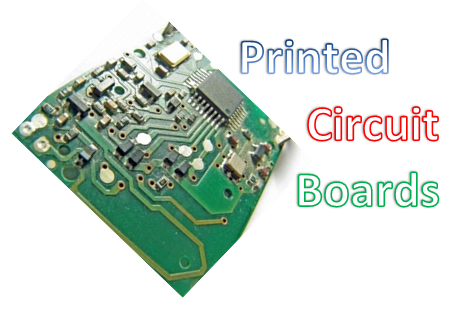Printed Circuit Board
PC Board (also called printed writing boards) or metal clad dielectrics with conductors etched onto one or both sides of the board. Three methods for fabricating PC boards are the (1) additive method, which involves electro less plates on bare boards to build up circuit layers; (2) subtractive method, which involves etching the board, or removing metal from a metal-clad board in the desired circuit pattern, and (3) semi-additive method, which is a combination of the additive and subtractive methods.
In the assembly process, electrical components are placed on the boards are fluxed, and the components are affixed and soldered to the boards. In wave, dip, and drag soldering, a molten solder is deposited on the boards. Flux is applied to reduce the surface tension and oxides on metal surfaces so that the solder will flow evenly. The three most common types of flux are rosin, organic acid, and synthetically activated fluxes. Flux residue and other contaminants need to be removed from the board after soldering. In general, contaminants include (1) water-insoluble or only materials, such as oil, greases, rosin, and waxes; (2) water-soluble materials, such as rosin flux activators, sodium chloride, and plating and etching salts; and (3) particulates, such as dust, and machining, drilling, and punching fragments.
If no-clean soldering processes are no utilized, cleaning processes are required to remove residues from the board. These include chlorinated solvents, are used in various steps of the PC board assembly process for mechanical and manual cleaning applications.
On a traditional PC board, electronic components are affected to the board by drilling holes on the board, inserting and crimping the leads, and then soldering the components to the board. There is currently a trend toward surface mount technology (SMT). Surface-mounted devices are small and have no connector leads. Because no holes are needed, the components are more densely packed on the board. SMT requires cleaners that can penetrate the smaller crevices and spacing between the components and the board. The recent phrase-out of ozone-depleting substances such as TCA and CFCs, has led to a higher use of aqueous and semi-aqueous cleaning systems.
Semiconductors
A semiconductor is a tiny complex of electronic components and their connections that is produced in or on a small slice of material, which may be composed of silicon, germanium, gallium arsenide, gallium phosphate, and semiconducting crystals. A large percentage of the ingots manufactured are silicon-based. Electrical current flows through a solid medium instead of a gas or vacuum as in other electrical devices.
The application of a semiconductor will determine the base material and the design, amount, and complexity of the circuitry. The base material and circuitry engineering are factors in the amount of wastes that are produced during manufacturing.
Average Acceleration Calculator
Average acceleration is the object's change in speed for a specific given time period. ...
When an object falls into the ground due to planet's own gravitational force is known a...
In Mathematics, the permutation can be explained as the arrangement of objects in a particular order. It is an ordered...
A rectangle can be explained as a 4-sided quadrilateral which contains equal opposite sides. In a rectangle
A three sided polygon which has three vertices and three angles is called a triangle. Equilateral triangle...







